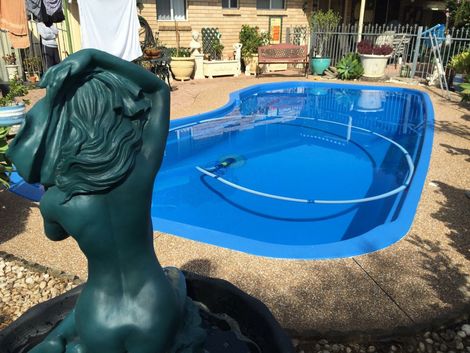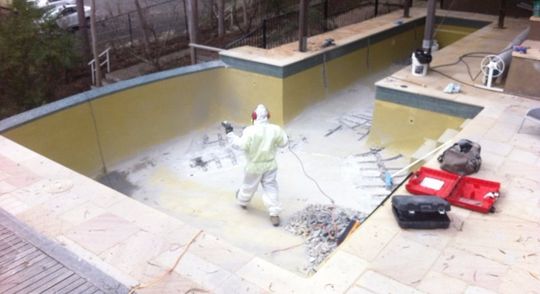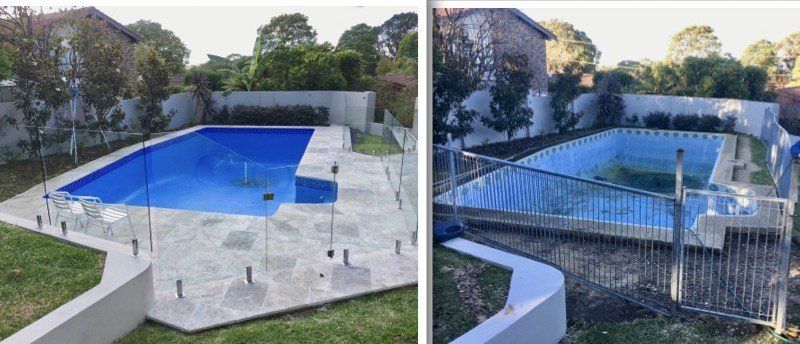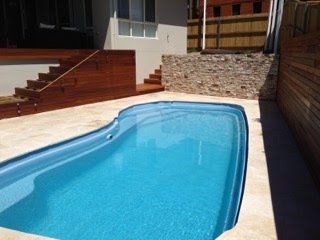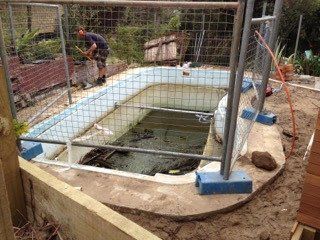Pool Resurfacing, Restorations Coating Comparisons
There are several pool resurfacing products on the market. Lets have a look at what is available. The list of the most popular resurfacing products goes like this: Click Here to Read More
Why use Fibreglass for Pool Resurfacing?
The following are several reasons to consider Fibreglass resurfacing as an alternative to re-Plaster / Pebblecreteing a swimming pool:
Fibreglass is much stronger than Plaster / Pebblecrete.
Fibreglass has its own structural integrity regardless of what it is applied to, while Plaster / Pebblecrete is brittle and relies upon the surfaces it is applied to for most of its strength. Click Here to Read More
Pool Resurfacing and Concrete Cancer
When the pool is first made, steel rio is installed to form and strengthen the walls. Over time water penetrates into the concrete, causing the steel within the concrete to rust. Concrete Cancer is what results from the rust. Concrete Cancer presents as rust marks in your pool. These discolorations effect the structural integrity of your pool.
The affected area needs to be cut out from the pool and then replaced with a sealant.
After this is completed, you are able to place a new concrete sealer over top and
carry on using your pool as is. There is a downside to this; Concrete Cancer will occur as long as you have water making prolonged contact with your pool’s concrete shell. How can you avoid Concrete Cancer and secure the long term life of your pool? The best solution for preventing Concrete Cancer is to choose fiberglass pool resurfacing!
The reasons for fibreglass’ superiority over concrete are numerous, not including the fact that you won’t experience Concrete Cancer again. The fibreglass shell acts as a non-porous barrier system, preventing any water from passing through to the concrete. In the rare occasion that water does make prolonged contact with the concrete, the fibreglass shell will keep the rust contained in the concrete, preventing it from entering your pool. In this fashion, the fibreglass will ensure a prolonged lifespan for your pool (up to 40 years!), and will drastically reduce the likelihood of any concrete cancer re-occurrence. With fibreglass pool resurfacing, you can kiss Concrete Cancer goodbye!
If you have any questions about fibreglass pool resurfacing or are interested in a no-obligation quote, we encourage you to contact us today!
Has Your Pool Seen Better Days?
Request a Quote for a no obligation visit by one of our trained professionals
Free Quote
How Long Does the Average Pool Resurfacing Job Take?
Summer is almost here! With all this amazing weather, we’ve been getting a lot of questions regarding how long the average pool resurfacing job takes from start to end (in other words, how long until I can have a pool party?!) Although every job is slightly different, we are able to offer some rough averages for how long each step in the Pool Resurfacing process takes, and how much time a resurface will generally take before you’ll be able to use your pool again.
The first step in our process is to drain and dry your pool. This step is probably obvious to most people, but we can’tstructural renovation stage 1 resurface your pool until all the water is drained out and the surface is completely dry. This is necessary because the product we put on your pool requires a dry environment in order to cure and seal properly. This process is weather dependent, but usually we budget 1-2 days of time to ensure the coating has had enough time to cure. Also important to mention, we will be careful to avoid any hydrostatic relief during this process, as explained in our How-To Winterize Your Pool blog.
After the coating has cured, we use a vinyl-ester resin to seal it up and protect it from the wear and tear of normal use. The sealing process usually takes up to 1 day.
Using a 450g Chop Strand Matting, we line your pool with the fibreglass laminate that will become the new surface of your pool shell. This process is critical, as the fibreglass will be the surface that will be absorbing the most use in your pool. After the laminate is on, we bond it to the vinyl-ester resin. This process will again take up to 1 day.
Once the laminate has hardened, we give it a light grind to remove any imperfections from the application and smooth structural renovation completethe surface out. After this is done, we apply a resin-based filler coat to the fibreglass shell.
Now that the filler coat has dried properly, grind it to remove any imperfections. After this is completed, we apply a top-coat of gel that will give the pool it’s smooth protective layer. This layer ensures that no water will enter the shell, and is one of the reasons that our Pool Resurfacings can last for up to 20 years! One final grind is applied to again remove any imperfections and uneven applications of the gel coats, but we are done after this process! Your pool will take generally 7 days to harden and seal, but after this you’re free to use it again!!
All told, a start to finish resurfacing job will take from 9-14 days depending on the weather, size of your pool, and if there are any unforeseen complications. This estimate doesn’t consider if you are having custom work done, like waterline tiles, stairs, or paving done around the pool.
We hope this information was valuable – if you have any questions or are interested in a no-obligation quote be sure to contact us!
Factors That Impact the Cost of a Pool Resurfacing Quote
How many of us have experienced sticker shock after receiving a quote from a contractor? Nothing sets a bad tone to a professional relationship quite like the belief that you’re being over-charged for a service. After resurfacing pools in Sydney for over 15 years, we’ve fielded many questions from our customers about what factors can impact the value of a quote. In the spirit of these questions, we decided to share exactly what we look at when we visit your home to discuss a job, and what sort of things factor into the value of the quote that we give you.
Size of the pool
The most basic factor is: How big is the pool that requires resurfacing? Most pool resurfacing companies will use the dimensions of the pool to calculate the total square meterage. This is a great way for getting a baseline for the price, as it gives the contractor an idea for how much material will be required for the job. It also tells us how many hours the job will take, which will impact the cost of labour. While the pool size is a large factor, there are other things we look at that can either decrease or increase the cost of the pool resurface.
Condition of the Pool
Pool Resurfacing and Osmosis Removal Before
Many times when we inspect a pool, said pool will have water in it. In some of these cases, the water will be black/murky, making it difficult for our staff to see what lies beneath the surface. Some things under the surface that may be concealed include osmosis, drummy, and general decay of the pool. These things are many times revealed after the job has begun, and cost extra time to tackle vs if the pool was in decent condition. Hidden issues like this will impact the amount of time the job will take, and likewise will increase the cost of the job.
Additional Features
A great way to think about additional features to your pool is to compare them to buying a new car. You can purchase the basic model of the car that you can drive off the lot that day, or you can add additional features and options that will increase the time and corresponding cost of the job. When it comes to resurfacing your pool, this is much the same. Are you looking for a simple resurface, or perhaps something more? Many times when we resurface a pool, the customer will request additional work such as adding waterline tiles, patio paving, pool coping, pool fencing, additional water features, stairs swim-up landings, etc. All of these things are extras, and will impact the overall cost of the job. That being said, it is always best to decide on these things before you begin the job, as the resurface should be the final part of the job if there is other work being done around the pool.
Access
Access to the job site can sometimes be an important factor in the cost of the job. While most resurfacing jobs are simple open-shut cases where access is not a factor. Some larger jobs can be time-costly with regards to moving heavy and bulky materials onto the site. This extra time required can in some cases increase the labour cost, and grow the cost of the quote.
That about sums it all up! There’s of course a few other minor factors here and there that will impact your quote price, but these are the big ones. If you have any questions or want to see our quotes in action, request a free quote or contact us today!
Questions You Should Ask Your Pool Resurfacing Contractor
While in operation for more than 15 years, all of us at Fibrestyle have worked to not just resurface your pool to better-than-new condition, but to educate our customers on how to maintain that pool for years to come. We’ve compiled a list of some of the best questions we’ve heard over the past years, and we encourage you to ask any pool resurfacing professional you choose some of the following questions.
Are you a registered/insured business that carries liability insurance?
This is extremely important, and should be your first question when discussing a job with a contractor. Any qualified business will carry extensive liability insurance, which will cover an employee if they get hurt. The importance of this cannot be overstated. Without liability insurance, an employee of the contractor who gets hurt on the job can potentially go after you (the homeowner) for damages. This insurance protects more than just the contractor, but you as well!
How long have you been in business?
Removing osmosis at the source
When dealing with a contractor that gives extensive warranties, the amount of time they’ve been in business can serve as proof of their skills. Giving a long term warranty on a service is great, but what happens if the contractor closes their business before you need to claim against that warranty? As a rule of thumb, if a business is offering a 7 year warranty, hopefully they’ve been around longer than this. This way you can be sure that they produce good work, and have not had to redo many (if any) jobs.
Have you done a job like this before?
You want to be sure that when you choose a contractor that their experience is in line with the scope of work. Ask the contractor what other jobs they have done in the past that compare to the one you’re offering, and if they have any references that they can give for the quality of their work.
What is the timeline from start to finish?
Most residential pools can be resurfaced over a 7 to 10 day period. Many companies use tents and tarps to cover the pool while work is being done, but there are some cases where the weather becomes a hindrance to the timeline. When dealing with fibreglass, resins and gel coats, the elements can take a real toll on the production. Under perfect conditions, 7 – 10 days is very reasonable, however it is always safe to add an additional 3-5 days for adverse weather conditions.
What precautions are taken to prevent damaging the pool or having it pop out of the ground?
We’ve all heard stories about hydrostatic relief causing pools to pop out of the ground, or the walls of a pool collapsing in (particularly in fibreglass pools and modular pools). A qualified pool resurfacing pro will take all the necessary steps to ensure that this doesn’t happen to you!
These necessary steps include:
Ensuring that the hydrostatic valve is operational, in order to relieve pressure under the pool
Bracing the walls of your pool to safeguard them against a collapse
Closely monitoring the pool while it is being emptied to observe any early signs of structural weakness
Is the bid an estimate or a quote?
How many of us have brought in a contractor to perform work under a given quote, and then receive a sticker shock at the end when you learn the quote wasn’t even close to the true cost of the job. Naturally, you want to know that the price that you are being provided is a firm and accurate. Furthermore you should request to see a formal statement of work, with every key deliverable item included in it.
Outdoor Pool Recently Resurfaced
Things that you want to make sure are in the statement of work:
Pool draining
Hydrostatic Valve replacement or repair
Pool preparation (drying and grinding)
Any built in items such as stairs or swim up landings
Resurfacing (and the associated steps)
Refilling instructions
Shedding Light on the Enemy of Fibreglass: Osmosis
Owning a pool can be a significant commitment, requiring annual maintenance and regular upkeep to maintain an ideal atmosphere for relaxation. Most pool owners know about some of the more common problems, like chemical imbalances and filtration system malfunctions, but are not aware of the potential issues that can come about as a pool ages. For pools that are ten to fifteen years old, issues may arise in the fiberglass surface, leaving pool owners flummoxed by the raised bumps and dark-colored blisters that develop. The cause? Osmosis.
Fibreglass Osmosis Bubbles
Here we have a pool that has osmosis behind the watertight seal.
Osmosis and Swimming Pools
The scientific definition of osmosis, which refers to the movement of molecules through a semi-permanent membrane, is a basic concept in high school biology, but the application of the term as it applies to pool surfaces is far less commonly known. In essence, osmosis, also known as black plague, refers to bumps or blisters that appear on a pool’s surface based on a failed watertight seal.
These imperfections exist permanently, or may come and go over time. The bumps that arise are often one to four inches in diameter, feel hard or porous to the touch, and may not pop or crack when stepped on or pressed. Some may leak a brown or black tar-like substance, causing alarm in pool owners concerned with possible safety consequences. Treatments like staining or popping will not diminish the effects, and shocking with high doses of chlorine can only exacerbate the problem.
Osmosis Signs and Causes
Grinding epoxy filler to eliminate osmosis
One of our teammates, using a grinder to smooth the epoxy filler we use to eliminate decay left by osmosis.
Osmosis occurs when air and water seep through a pool’s lining, an issue often caused by poor consolidation of laminate or the presence of an unreacted cobalt accelerator. These issues can arise in any number of ways, but are generally related to the installation and care of a pool.
Faulty Construction Techniques
Many osmosis issues have to do with the quality or kind of laminate or poolcoat placed on the pool’s interior surface, and are often connected to the outdated technology used to seal pools over the last several decades. Most fiberglass pools are coated with a cloth mat soaked in resin that is covered by a gel coat. This construction technique isn’t perfect, however, leading to water saturation in portions of the cloth mat. When this occurs, the brownish black blisters arise, separating the gel coat from the mat and creating an expensive fix for pool owners.
Over the last several years, however, manufacturers began including an additional layer of vinylester resin between the mat and gel coat in order to provide a watertight barrier. This addition provides an extra layer of protection, preventing water from seeping through to the cloth mat. This is most effective when gelcoat is sufficiently thick enough, and the gelcoat is allowed to cure for the proper amount of time; otherwise, even an enforced lining can succumb to osmosis damage.
Poor Maintenance
Another successful pool resurfacing
Another New South Wales pool saved from osmosis by the outstanding Fibrestyle team!
When maintenance and operating conditions of a pool are ignored, osmosis is far more likely. Excessive exposure to heat can speed up the process; as such, pools kept at a high temperature are much more likely to suffer consequences. Pools expected to be kept warmer than 86 degrees Fahrenheit at a regular basis should be constructed with heat and chemical resistant resins rather than standard products.
Chemical use can also be a factor. When chlorine levels are too high, especially in conjunction with high temperatures, black plague is more likely to occur. Pool shock can be an especially dangerous factor; increased use of shock can rapidly accelerate the process, leading to osmosis signs years ahead of schedule. To reduce this risk, ensure your pool’s pumps are functioning normally, and track both chlorine and pH regularly.
Osmosis is an unwelcome sign in any pool, but understanding what you’re up against can help you find the right fix. At first sign of black plague in your pool, it’s important to seek professional attention to diagnose your issues and provide an appropriate remedy, bringing your pool back up to par as quickly and affordably as possible. If you think you may have an osmosis problem, give us a call or request a quote and we will investigate any issues you may be having.
Top Signals You Need Pool Resurfacing
As pool resurfacing experts, we are often asked the question, “How do I know that it’s time to think about resurfacing my pool?” These are some common indicators that it is time to consider pool resurfacing:
Fibreglass Pools
Osmosis:
This is the nemesis of fibreglass. The gel coat – which we call the topcoat in industry – that you can see on the pool’s surface is the coating that protects the fiberglass from the harsh chemically enhanced water in the pool. There is no topcoat on the outside of the pool shell, as it is “buried” in the ground. Over the lifespan of the pool, water and moisture from around the back of the pool tracks it way through the unprotected fiberglass laminate and forms a blister when it reaches the surface inside the pool (the topcoated side). Osmosis is very common in fiberglass pools, though the good news is that it can be repaired. The blisters are cut open and the “rotten” fibrous material is cleaned out. Once they are clean and dry, the void is filled with a fiberglass filler and sanded smooth. Then the pool has to be relaminated & resurfaced to waterproof and reinforce the structure of the pool. Finally, a new protective topcoat is applied.
Cracking:
Fibreglass pools are highly susceptible to cracking when they are not looked after. A fiberglass pool is at its most vulnerable when empty – and if you don’t know what signs to look for, they are at high risk of cracking.
Chalky:
We use this term when the topcoat (protective barrier) is very brittle and breaks down into the water, leaving it looking like milk. If you wipe your hand on the surface in the pool or brush the surface you will notice a “cloud” of dust mixing in the water. Over the years of being subjected to high levels of UV and chemicals, it’s a natural phenomenon for the surface to break down.
Exposed Fibreglass:
Once the topcoat gets brittle and starts breaking down, the fibreglass begins to become exposed. When this happens, the fiberglass will start to deteriorate at a faster rate and will release tiny fibers into the water, weakening the area and the integrity of the pool. Additionally, these fibers can get under one’s skin & cause itchiness and irritation.
Delaminating:
Delaminating normally only occurs if the pool has been resurfaced in the past. This is when the fiberglass surface in separating from the original surface. This could happen if the fiberglass has not been applied to the original surface correctly, or a gradual ingression of water behind the fiberglass.
Concrete/Pebblecrete Pools
Drummy:
Drummy or hollow areas in a concrete pool are the opposite of osmosis. These areas are caused from the water penetrating through the cementitious barrier surface and causing delamination between the pools’ concrete structure and the current surface in the pool. This normally occurs over a long period of time or if the barrier surface has been poorly applied. These areas have to be removed, the concrete prepared and rendered smooth before we commence the resurfacing procedure.
Calcium:
Through the water you can see calcium nodules “growing” on the surface. This is an indication that water is ingressing through the barrier surface and starting to form a delamination or drummy area.
Black spot:
Black spot is exactly what its name indicates. It is a host of black spots that become apparent throughout the pool surface and cannot be removed with brushing the surface or by heavily dosing the water with additives designed to remove this phenomenon. Alternatively, after the mentioned treatment the black spot keeps re-occurring. It is areas in the surface that have started to break down, causing small pockets for the algae to grow and stay “protected”.
Peeling paint:
In some instances the original surface of the pool was a smooth render coated with a pool paint. This tends to have a short life span in comparison to a fibreglass surface. Peeling of the paint is a common occurrence as well as chalking [as mentioned in the fibreglass section].
Grey Areas:
These are areas in the surface that start to become grey. The reason for this is that the protective coating has worn away and the substrate of the pool is starting to become exposed. Once this occurs it could accelerate the occurrence of “concrete cancer” forming, which in turn creates a more expensive resurfacing process.
Concrete Cancer:
This process is common in all concrete pools. It is when the reinforcing steel used in the construction of the pool shell becomes rusty and bursts through the concrete, as well as the protective coating. There are many reasons for this, but the age of the pool is the main factor: over time, water penetrating causes the steel to rust.
Vinyl Pools
Punctures:
A vinyl liner in a pool is basically a plastic liner that is fitted inside a pool shell. The construction relies heavily on the internal water pressure of the pool to keep its shape in most cases. Any sharp object has a tendency to pierce a small hole in the liner and water loss will occur or a large water bulge will form under the liner.
Delamination from Fitting:
The liner is fitted into a rail fixing system around the top edge of the pool. A common problem is that the liner starts to come away from the fixing allowing water to get behind the surface causing water loss and further delamination from the fixings.
We are here to help if you have any further questions. Please feel free to reach out – we’d be happy to do a free on-site assessment of your pool to help plan out your next options. Get in touch here.
Feel like you just don’t know enough yet? Check out our blog post that discusses your options depending on what ails your pool.

